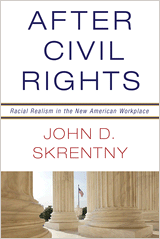
After Civil Rights: Racial Realism in the New American Workplace

- About
- Contents
About
(distributed by Princeton University Press)
By John D. Skrentny
Published 2013, 416 pages, hardcover
~Winner of 2015 Western Social Science Association Distinguished Book Award
~Winner of 2014 Richard A. Lester Award for the Outstanding Book in Labor Economics and Industrial Relations
~Finalist for the 2014 Benjamin L. Hooks Institute for Social Change National Book Award, The University of Memphis
~Honorable Mention for the 2015 Oliver Cromwell Cox Book Award, Racial and Ethnic Minorities Section of the American Sociological Association
What role should racial difference play in the American workplace? As a nation, we rely on civil rights law to address this question, and the monumental Civil Rights Act of 1964 seemingly answered it: race must not be a factor in workplace decisions. In After Civil Rights, John Skrentny contends that after decades of mass immigration, many employers, Democratic and Republican political leaders, and advocates have adopted a new strategy to manage race and work. Race is now relevant not only in negative cases of discrimination, but in more positive ways as well. In today’s workplace, employers routinely practice “racial realism,” where they view race as real–as a job qualification. Many believe employee racial differences, and sometimes immigrant status, correspond to unique abilities or evoke desirable reactions from clients or citizens. They also see racial diversity as a way to increase workplace dynamism. The problem is that when employers see race as useful for organizational effectiveness, they are often in violation of civil rights law.
After Civil Rights examines this emerging strategy in a wide range of employment situations, including the low-skilled sector, professional and white-collar jobs, and entertainment and media. In this important book, Skrentny urges us to acknowledge the racial realism already occurring, and lays out a series of reforms that, if enacted, would bring the law and lived experience more in line, yet still remain respectful of the need to protect the civil rights of all workers.
Contents
Chapter 1: Managing Race in the American Workplace 1
Chapter 2: Leverage Racial Realism in the Professions and Business 38
Chapter 3: We the People Racial Realism in Politics and Government 89
Chapter 4: Displaying Race for Dollars Racial Realism in Media and Entertainment 153
Chapter 5: The Jungle Revisited? Racial Realism in the Low-Skilled Sector 216
Chapter 6: Bringing Practice, Law, and Values Together 265
